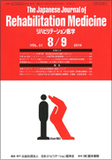Japanese
English
- 販売していません
- Abstract 文献概要
- 1ページ目 Look Inside
- 参考文献 Reference
要旨 目的:システム理論に基づくバランス機能評価,Balance Evaluation Systems Test(BESTest)の日本語版を作成し,その妥当性を検証した.方法:翻訳と逆翻訳を経て日本語版BESTestを作成した.バランス障害群20名及び健常群5名(平均年齢71.2±13歳,66.0±1.2歳)に日本語版BESTest,Berg Balance Scale(BBS),国際版転倒関連自己効力感尺度(FES-I),Activities-specific Balance Confidence Scale(ABC Scale)を実施し,Spearmanの順位相関係数を求めた.またBBSと日本語版BESTestによるバランス障害群と健常群との判別能をROC解析により比較した.結果:日本語版BESTestはBBS(r=0.84),FES-I(r=-0.61),ABC Scale(r=0.63)と有意な相関を認めた(p<0.01).BBS及び日本語版BESTestのROC曲線下面積(AUC)は0.75,0.94(p<0.05)であり有意差を認めた.結論:日本語版BESTestは既存の評価法との妥当性を示し,BBSよりも軽度のバランス障害の検出に優れると考えられた.
Abstract Objective : The Balance Evaluation Systems Test (BESTest) is a new balance assessment set based on systems theory. The purpose was to examine the validity of the Japanese version of the BESTest (J-BESTest) that we translated. Methods : The J-BESTest was produced using a translation and back translation method referenced from a guideline proposed by Guillemin et al. We tested 20 patients with balance dysfunction due to various diseases and 5 healthy persons with the J-BESTest, the Berg Balance Scale (BBS), the Falls Efficacy Scale-International (FES-I) and the Activities-specific Balance Confidence Scale (ABC Scale). We assessed the concurrent validity of the J-BESTest by comparing it with the other measures using Spearman's correlation method. Furthermore, we compared the ability of the J-BESTest to discriminate balance dysfunction with that of the BBS using receiver operating characteristic (ROC) analyses. Results : The J-BESTest was highly correlated with BBS (r=0.84, p<0.01), FES-I (r=-0.61, p<0.01) and ABC Scale (r=0.63, p<0.01). The distribution of the BBS score was more skewed compared with the J-BESTest and had a ceiling effect (6 participants had perfect scores with BBS versus none with the J-BESTest). The area under the ROC curve (AUC) of the J-BESTest was significantly larger than that of BBS (BBS 0.75, 95% confidence interval 0.56-0.94 versus J-BESTest 0.94, 95% confidence interval 0.84-1.0, p<0.05). Conclusion : The J-BESTest was suggested as a clinically useful tool, with good concurrent validity and better sensitivity and specificity than BBS, to identify people with mild balance dysfunction.

Copyright © 2014, The Japanese Association of Rehabilitation Medicine. All rights reserved.


